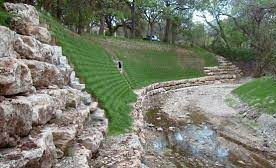Geoweb retaining walls are a popular choice for stabilizing slopes and preventing erosion. These walls are made up of interconnected cells that are filled with soil or aggregate, providing a strong foundation for vegetation to grow and stabilize the slope. Here is a step-by-step guide to installing a Geoweb retaining wall:
Determine the size and shape of the retaining wall:
Before beginning the installation process, you will need to determine the size and shape of the retaining wall. This will help you determine how much Geoweb material you will need.
Excavate the area:
The first step in installing a Geoweb retaining wall is to excavate the area where the wall will be installed. This will create a level base for the wall to rest on. Be sure to remove any rocks or debris from the excavation area.
Install the Geoweb:
Begin by installing the Geoweb material at the base of the retaining wall. The Geoweb comes in large rolls that can cut to size. Unroll the Geoweb and lay it out over the excavation area. Cut the material to size using a utility knife or scissors.
Secure the Geoweb:
Once the Geoweb is in place, it needs to secure to the ground to prevent it from moving during the installation process. Use stakes or pins to secure the Geoweb to the ground.
Fill the Geoweb:
After the Geoweb secure, it needs to be fille with soil or aggregate. This will provide a strong foundation for the vegetation to grow and stabilize the slope. Use a loader or shovel to fill the Geoweb cells with soil or aggregate.
Compact the soil or aggregate:
Once the Geoweb is filled with soil or aggregate, use a compactor to compact the material. This will help to ensure that the material is evenly distributed and provides a strong foundation for the vegetation to grow.
Repeat the process:
Continue the process of installing the Geoweb material, securing it to the ground, and filling it with soil or aggregate until the retaining wall is the desired height.
Plant vegetation:
Once the retaining wall is in place, it is time to plant vegetation. Choose plants that well-suit for the climate and soil conditions in your area. The vegetation will grow through the Geoweb cells and help to stabilize the slope.
Maintain the retaining wall:
To ensure that your Geoweb retaining wall lasts for many years, it is important to maintain it properly. This may include periodic inspections to check for any damage or erosion, as well as regular maintenance of the vegetation.
Benefits of a Geoweb Retaining Wall
There are several benefits to installing a Geoweb retaining wall:
- Environmentally friendly: Geoweb retaining walls are environmentally friendly, as they provide a stable foundation for vegetation to grow and prevent erosion.
- Easy to install: Geoweb retaining walls are relatively easy to install, especially if you have experience with DIY projects.
- Cost-effective: Geoweb retaining walls are a cost-effective solution for stabilizing slopes and preventing erosion.
- Durable: Geoweb retaining walls are durable and long-lasting, making them a great choice for areas that are prone to erosion.
- Versatile: Geoweb retaining walls can use in a variety of settings, including residential, commercial, and industrial.
Conclusion
Installing a Geoweb retaining wall can be a great way to stabilize slopes and prevent erosion. By following these steps, you can ensure that your Geoweb retaining wall install properly and functioning as intended. With its many benefits, a Geoweb retaining wall can be a smart investment for any property owner looking to stabilize their slopes and prevent erosion.

